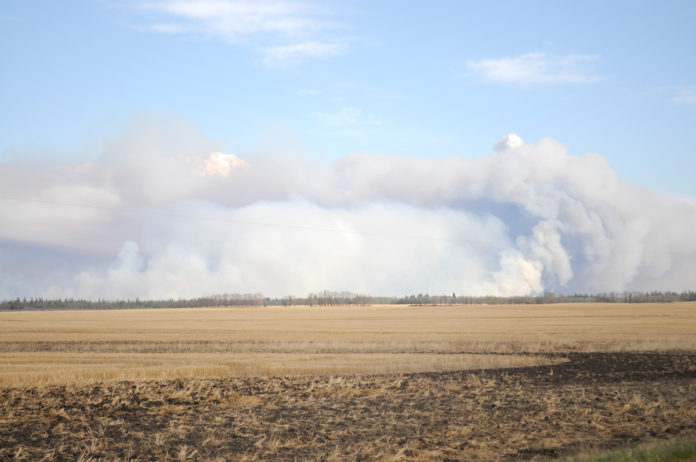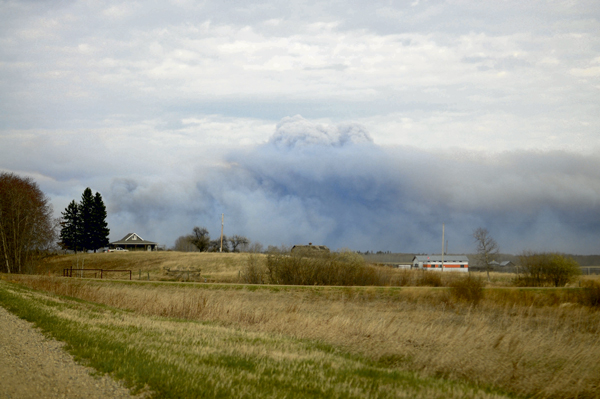
An abundance of old, dead underbrush and swirling winds are complicating matters for the small fire crew working on containing a large wildfire burning in the Fort à la Corne Provincial Forest.
Named the English fire after a fire tower in the area, the blaze was human-caused and ignited on May 8. It’s unknown what the precise cause of the fire was.
The province held a press conference Tuesday morning to provide an update on the fire. While it only measured 5,300 hectares Friday evening, it had grown to 37,500 hectares by Tuesday morning.
That size, equivalent to 375 square kilometres, makes the fire 1.7 times larger than the City of Saskatoon, or 5.8 times larger than the City of Prince Albert.
The fire has grown in all directions, reaching the North Saskatchewan River in the south and burning past the northern edge of the forest and into farmland. It’s now burning about three miles south of Highway 55. Farmers and members of the Smeaton Fire Department were busy over the weekend tackling areas the fire burst free from the confines of the forest.
Currently, 45 firefighters, made up of teams from four different First Nations, are fighting the blaze, supported by 11 bulldozers and heavy equipment, nine crew trucks, six helicopters, four planes designed to drop retardant and one water bomber.
According to Steve Roberts, acting vice-president of operations for the Saskatchewan Public Service Agency (SPSA), as of Tuesday morning, no permanent residents are evacuated and no structures have been reported lost.
So far, the wind has been one factor challenging crews’ efforts.
“The forest type is a very mature, or over-mature,” he said.
“There are large amounts of dead and blowdown material in there. There has been no appreciable fire activity in there for decades. There is lots of available fuel burning in the spring … and we have heavy loads of tall grasses and brush material as well to carry the fire.”
That, combined with strong winds, has pushed the fire through “very volatile fuel,” Roberts said.
“It’s much like a grass fire on a larger scale. That’s been difficult. That’s why we’ve seen a large amount of spread.”
Rio Tinto has a diamond exploration project, and the site of a proposed future diamond mine, near the fire. In a statement, the company has said it evacuated all but essential staff and set up sprinklers and fire guards to protect its properties.
While James Smith Cree Nation had evacuated some vulnerable community members due to smoke concerns, Roberts said they had since been returned to their home communities.

Neighbours on the north side of the fire have been working to prepare to evacuate if need be, but they have also taken actions such as plowing farmland and agricultural land so the fire can’t cross onto their properties.
So far, only four crews have been brought in. The presence of COVID-19 concerns has led to restrictions on how many people can be accommodated at one time.
“We have certain provisions that will prevent us from bringing large groups of folks and camping them,” Roberts said.
“They will have to be accommodated in smaller groups to meet COVID-19 restrictions our agency has in place.”
Roberts said Tuesday that a single water bomber, brought down from La Ronge, is working on the fire. There is only one nearby water source, limiting the amount of scooping and dumping that can occur.
The province’s other water bombers are still in post-winter maintenance and not ready to fly. Still, only one or two would be typically used for a fire like this, Roberts said.
Instead, six helicopters are providing bucketing and four fire retardant tankers based in Prince Albert have been deployed as well.
The focus is on containing the fire. Crews are using a combination of bulldozed fire guards and aerial ignition to stop its spread.
“What the (aerial ignition crew’s) task is to setup up some control lines with heavy equipment and existing road structures. They will actually ignite the fuel between those to create a blackened, burned-out barrier to prevent the fire from moving any further,” Roberts said.
Those types of operations are best supported by retardant, not water, he added.
As for fire guards, they aren’t one continuous line, rather a series of guards at key areas. Roberts was unable to estimate how much of the fire was surrounded by guards. Crews, though, are preparing for shifts in the wind direction as a large storm is expected to roll through in the next 24 hours.

Nearby communities are on alert to evacuate if need be. While small family groups can self-evacuate, if a larger group needs to be moved out, the SPSA has to consider the impacts of COVID-19.
“We need to look at how to space them out, if we would provide masks if we have to bust them out,” he said.
“We have to look at critical folks with health issues because not only is moving them out an issue but are we increasing or decreasing their exposure risk if we do so? The idea of having them in a group setting like a gymnasium or skating risk would be curtailed by COVID-19. We’d be looking at far fewer folks in a single area or using hotel rooms to keep people separated.”

